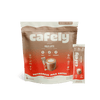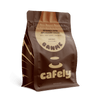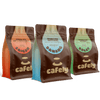Decaf coffee is normally made one of two ways:
- Instant decaf coffee is made by passing brewed coffee through a charcoal filter before freeze-drying it.
- Whole-bean or ground decaf coffee is usually made by soaking green coffee beans in a solvent such as methylene chloride or ethyl acetate before rinsing and roasting.
Both of these methods remove caffeine — but only up to 97%.
This means so-called “decaf” coffee does contain some level of caffeine. So, how much caffeine is in decaf coffee, and is it enough to induce stimulating effects?
Read on to find out…
The Caffeine in Decaffeinated Coffee
Decaffeinated coffee does contain some caffeine, although a lot less than regular caffeinated coffee. Most methods of decaffeination remove 97% to 99% of the caffeine in coffee beans.
Regular arabica coffee contains around 10 mg of caffeine per gram, whereas decaffeinated coffee contains around 0.5 to 2.5 mg of caffeine per ounce — sometimes higher. This equates to around 4 to 18 mg per brewed cup of decaf and 60 to 170 mg per cup of regular drip coffee.
Keep in mind that these figures vary depending on the brand of coffee and the brewing method used to create the cup. The exact amount of caffeine in a cup of decaf coffee can vary significantly depending on the bean or blend and the decaffeination process used by the manufacturer.
Folgers decaf coffee contains the least amount of caffeine — around 0.04 mg per ounce.
It’s also worth noting that some decaf beverages from popular coffee chains — such as Starbucks coffee and Dunkin’ Donuts — contain much more caffeine than a typical store-bought decaf blend.
Caffeine Levels in Different Decaf Coffee Brands

The caffeine levels in decaf coffee vary by brand. Different manufacturers use different beans, blends, and decaffeination processes. This leads to slightly different caffeine levels from brand to brand.
Use the table below to learn how much caffeine is in your favorite decaf coffee:
|
Decaf Coffee Brand |
Caffeine (mg/oz) |
Caffeine Per 8 oz (204 mL) Cup |
|
Nespresso Decaf |
0.25–0.5 mg |
2–4 mg |
|
Nescafe Instant Decaf |
0.62–1 mg |
5–8 mg |
|
Folgers Decaf |
0.04 mg |
0.32 mg |
|
Peet’s Espresso Coffee Decaf |
6.67 mg |
53.36 mg (10 mg per 60 mL shot) |
|
Caribou Coffee Decaf |
0.5–0.625 mg |
4–5 mg |
|
Tim Hortons Decaf |
0.5 mg |
4 mg |
|
Starbucks Decaf |
1.56 mg |
12.5 mg |
|
Dunkin’ Donuts Decaf |
1.12 mg |
9 mg |
|
McDonald's (McCafe) Decaf |
0.66 mg |
5.28 mg |
|
Generic Store Brand Decaf |
0.5–2 mg |
4–16 mg |
How Does Decaf Coffee Compare to Regular Coffee?
Although decaf coffee does contain caffeine, it contains significantly less than regular coffee.
Here’s how the caffeine in decaf coffee compares to different brews:
- Drip Coffee — 95–165 mg of caffeine per 8 oz cup.
- Espresso Coffee — 75 mg of caffeine per shot.
- Latte Coffee — 75–150 mg per 8 oz cup.
- French Press Coffee — 100–137 mg per 8 oz cup.
- Pour-Over Coffee — 90–160 mg per 8 oz cup.
- Cold Brew Coffee — 197–213 mg per 16 oz serving.
- Instant Coffee — 80–180 mg per 8 oz cup.
- Vietnamese Coffee — 70–200 mg per 8 oz cup.
How Much Caffeine Is Considered Safe?
The Food and Drug Administration (FDA) recommends that adults restrict their caffeine consumption to less than 400 mg per day. This level is considered safe and is equal to around four cups of regular drip coffee, five to six single espresso shots, or two to three cups of cold brew.
Although it’s likely okay for a healthy adult to consume slightly more caffeine than the FDA’s recommended allowance, for some people, this level may be far too high. Certain people should limit their caffeine intake or cease consumption entirely.
People who should limit their caffeine intake include:
- Pregnant women
- People with heart conditions
- Individuals with anxiety or panic disorders
- People with sleep disorders or insomnia
- Children and teens
- People with high blood pressure
- Those sensitive to caffeine
- People on certain medications
Alternatives to Decaf Coffee (0 mg of Caffeine)
If you’re particularly sensitive to caffeine and want to avoid it completely, several alternatives can provide the same comforts and a similar experience to coffee.
Herbal teas are the best options — they can be consumed hot or cold like iced coffee and may offer a host of health benefits.
Here are five great caffeine-free alternatives to coffee:
1. Rooibos Tea (Red Bush)

Rooibos tea comes from a shrub called Aspalathus linearis, that's native to South Africa. Often dubbed "red bush" for its distinct red color, this herbal tea is the perfect alternative to coffee.
Rooibos has a unique tea-like taste and naturally sweet yet bitter flavor. It contains high levels of antioxidants, has a lower acidity than coffee, and is naturally caffeine-free.
Rooibos tea can be consumed hot or cold. It’s naturally sweet, so it tastes fantastic without sugar, and it can be consumed black without milk. This brew also tastes surprisingly good with milk — perfect for those people looking for a latte-like fix without the caffeine.
2. Chamomile Tea

Chamomile tea is a hot herbal infusion made from the flowers of the Matricaria chamomilla plant. This tea has a mild, floral, and naturally sweet taste that may make it a good alternative to coffee.
Chamomile tea can be consumed hot or cold but does not pair well with milk. The infusion is packed with antioxidants and may help promote relaxation and sleep.
Unlike coffee and some teas, chamomile is not a diuretic, meaning it doesn't induce dehydration. If you're looking for a caffeine-free alternative to coffee that still provides the warmth, comfort, and experience of coffee with its stimulating, diuretic effects, chamomile tea could be a fantastic option.
3. Peppermint Tea

Peppermint tea is made from the leaves of Mentha × piperita. It's a refreshing infusion that can be drunk hot or cold. It has a natural sweetness and a cool, fresh aftertaste thanks to its menthol content.
Peppermint tea is an excellent caffeine-free alternative to coffee because it provides a similar drinking experience and a potential energy boost. While peppermint doesn't contain caffeine, the menthol within an infusion provides a refreshing, “awakening” sensation that may improve energy and focus.
Peppermint tea may also harbor a range of other benefits. The tea is often used as a digestive aid to support relaxation, relieve headaches, and reduce stress. Although this tea has an acquired taste and doesn't have a similar flavor profile to coffee, its energy-boosting properties and overall drinking experience make it a good alternative.
4. Ginger Tea

Ginger tea is a warm infusion made by soaking fresh or dried ginger root (Zingiber officinale) in hot water. It has a warm, spicy, slightly sweet taste with a soothing and invigorating effect. Although ginger tea doesn't contain any caffeine, ginger's warming sensation and ability to improve circulation may provide a sustainable energy boost.
Ginger tea is typically served warm, but it can be cooled and served over ice with a touch of lemon. Not only can this drink provide a potential energy boost, but it may also promote healthy digestion, reduce inflammation, boost the immune system, support metabolism, and ease stress.
If you're looking for a healthy alternative to your morning cup of coffee and enjoy the warm, spicy taste of ginger, this tea could be a fantastic option.
5. Hibiscus Tea

Hibiscus tea is an infusion made from the dried petals of the hibiscus flower (Hibiscus sabdariffa). This brew has a tart, cranberry-like flavor with a bitter edge that's comparable to a light roast coffee. The drink has a deep red color and can be enjoyed hot or cold.
Hibiscus tea is caffeine-free and naturally energizing. Its vibrant, tangy taste and tart, bitter edge can provide an uplifting feeling in the morning, especially when consumed hot.
Hibiscus is also rich in antioxidants and may help boost metabolism and aid in weight management.
If you're looking for a refreshing brew with a slightly similar flavor profile to coffee, hibiscus tea is an excellent alternative.
FAQs: Caffeine in Decaf Coffee
Want to learn more about decaf coffee and other decaffeinated beverages?
Check out the answers to the frequently asked questions below…
1. Does Decaf Coffee Contain Caffeine?
Yes. Although “decaf” coffee is often marketed as containing “no caffeine,” the decaffeination process removes around 97% of the caffeine. However, the trace levels of caffeine are so minute that the substance is unlikely to affect the body.
2. Is There a Decaf Coffee With Zero Milligrams of Caffeine?
The decaffeination process removes around 97% of the existing caffeine in coffee. An average 8 oz cup of decaf contains around 7 mg of caffeine. It’s not possible to remove 100% of the caffeine from coffee, so there is not (yet) a brand that makes a completely caffeine-free decaf product.
3. How Much Caffeine is in Green Tea?
There is 10 to 45 mg of caffeine in a standard cup (6 to 8 oz) of green tea. This is around half the amount of caffeine in black tea and almost double the amount of caffeine in white tea.
4. What’s the Best Decaf Alternative to Coffee?
If you want a completely caffeine-free alternative to coffee, there are several good options out there. Herbal teas such as chamomile, peppermint, rooibos (redbush), ginger, and licorice are all great zero-caffeine alternatives to coffee.
5. How Is Decaf Coffee Made?
There are several ways that decaffeinated coffee is made. The most common is solvent extraction. By using methylene chloride or ethyl acetate, manufacturers dissolve 97 to 99% of the caffeine from green coffee beans. The beans are then rinsed and roasted.
6. How is Instant Coffee Made?
Instant coffee is usually made by brewing a large volume of coffee and then freeze-drying or spray-drying the brew to remove the moisture. The resulting dry material is powdered and granulated to create instant coffee that dissolves in hot water.
7. What Type of Coffee Contains the Most Caffeine?
The strongest type of coffee is robusta variety. These beans contain around twice the amount of caffeine per gram as arabica coffee beans. The average 8 oz cup of Vietnamese robusta coffee contains around 200 mg of caffeine.
8. Can You Overdose on Caffeine?
The lethal dose (LD50) of caffeine is estimated at 10,000 mg (10g) — that's a lot of coffee. However, although it's almost impossible to consume enough coffee to overdose on caffeine, it’s possible to induce toxicity with much lower levels.
Consuming 1000 mg of caffeine in a short period can lead to toxicity symptoms such as jitters, restlessness, increased heart rate, anxiety, paranoia, nausea, and vomiting.
9. Does Caffeine Cause Heart Palpitations?
Caffeine can cause heart palpitations and increased heart rate if consumed in large quantities. If you are experiencing heart palpitations from drinking coffee, reduce your intake and seek medical advice.
10. Does Red Bull Have More Caffeine Than Coffee?
A standard 8.4 oz can of Red Bull contains 80 mg of caffeine — that's around the same as an 8 oz cup of drip coffee made with arabica coffee beans. However, Red Bull contains significantly more sugar (27 grams) and sodium (105 mg), as well as sucrose, glucose, artificial colors and flavors, and other additives.










